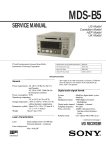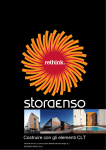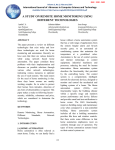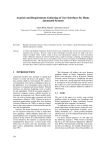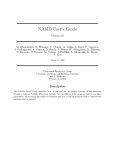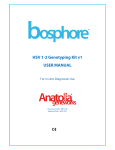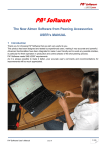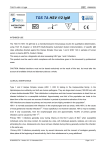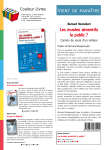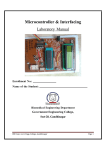Download HOME AUTOMATION SYSTEM - Technical Journals Online
Transcript
International Journal of Advanced Engineering Technology E-ISSN 0976-3945 Review Article HOME AUTOMATION SYSTEM Sajidullah S. Khan1, Anuja Khoduskar2, Dr. N. A. Koli3 Address for Correspondence 1 Prof. Ram Meghe Institute of Technology & Research, Badnera-Amravati. Maharashtra, INDIA 2 Dr. Panjabrao Deshmukh Polytechnic, Amravati. Maharashtra, INDIA 3 Sant Gadge Baba Amravati University, Amravati. Maharashtra, INDIA E Mail [email protected] ABSTRACT This home automation system mainly focused on the design and implementation of a system that control various appliances at home. The design is having Micro controller as its heart and this controller board is connected to the server at the home. Various home appliances are connected to system board with the input/output port. Most of the sensors & transducers such as temperature, humidity, pressure, are analog. For interfacing these sensors to micro controllers require to convert the analog output of these sensors to digital so that the controller can read it. This system is scalable as new appliance can be added with small change in core system appliances can be controlled locally as well as remotely through network connection. 1. INTRODUCTION With the fast development in the field of computer technology, Home automation provides a more convenient & elegant atmosphere for the family to compliment and match the lifestyle. Every one in the family experiences the comfort of automation with added convenience through integrated control of scheduled common lifestyle activities performed everyday. An automated home can provide security, temperature, lighting, and audio control for comfort, convenience, and safety. It creates reliable and coordinated controls to operate home devices automatically. The computer network allowed development of the idea of an online control of various electrical appliances. This system needs to enhance home and lifestyle with clever home automation that can easily monitor and control home devices; it also provides safety of equipments, which now operate precisely as per recommendations. It gives Convenience and comfort as well as Cost and time saving by optimized operation for longer life. As we know because of rapid development of new technologies such as Java the computer network has also started to serve as a medium that allows the monitoring, control, and interaction with machine and devices. The computer network can be used in home automation, which provides many features ranging from efficient use of energy to increased comfort, greater safety and security. 2. TOOLS REQUIRED: a) Java is used as Source Development Kit b) NetBeans 5.5 is used as IDE c) Tomcat Apache 5.5 is used as the server IJAET/Vol.II/ Issue II/April-June, 2011/129-132 d) Servlets are used for client - server communication e) JNI Java Native Interface is used for hardware interfacing f) RxTx Serial Port Library is used to interface microcontroller g) Oracle/Microsoft access is used for database. This system needs following Hardware as well as Software Components for its development. 3. Hardware Components (a) Micro controller 89c51 It is used at the heart of the hardware which is a lowpower, high-performance CMOS 8-bit microcomputer with 4K bytes of Flash programmable and erasable read only memory.[9] Port 0 is also configured the multiplexed low order address/data bus during accesses to external program and data memory. Port 0 also receives the code bytes during Flash programming, and outputs the code bytes during program verification. Port 1 is an 8-bit bidirectional I/O port .Port 1 also receives the loworder address bytes during Flash programming and program verification. As it is used for connection to ULN for various high voltage device appliance control. As inputs, Port 2 emits the contents of the P2 Special Function Register. Port 2 also receives the high-order address bits and some control signals during Flash programming and verification. Port 3 also serves the functions of various special features of the AT89C51. P3.0 RXD used for Serial Input Port and P3.1 TXD used as Serial Output Port. Port 3 also receives some control signals such as RST, VPP +5V dc power, XLAT1, XLAT 2 International Journal of Advanced Engineering Technology (b) ADC 0808 It is used to convert analog values from sensors to digital values that can be read by micro controller. The sensors can be temperature or intrusion detection sensors, etc.The ADC used to convert analog signals from sensors to equivalent digital signals that could be interpret by the microcontroller. The ADC0808, ADC0809 offers high speed, high accuracy and repeatability and consumes minimal power. (c) ULN2803 ULN2803 is the Darlington driver used to control +12V devices like Relays (Electromagnetic Switches), Buzzers etc. Relays can be used to control 230V AC devices .this hardware can also be used to provide feedback to the system via actuators or it can be used to control electrical devices (using relays). (d) ULN2803 MAX232 is used to interface micro controller with PC's Serial Port. It converts PC side voltage levels (+9 and -9) to micro controller side voltage levels (+5 and 0) and vice versa. It is used for communication between PC and hardware controller. (e) Relay A relay is electrically operated switches, which allow low power circuits to switch a relatively high Current/Voltage ON/OFF. For a relay to operate a suitable pull-in & holding current should be passed through its coil. Relay coils are designed to operate from a particular voltage often its 5V or 12V. The function of relay driver circuit is to provide the necessary current to energize the relay coil, when a LOGIC 1 is written on the PORT PIN thus turning ON the relay. The relay is turned OFF by writing LOGIC 0 on the port pin .In our system two relays are used for device control. 4. PROPOSED WORK System Features Our system introduces the following features: 1. Visual Menu of home appliances, that user want to control through application software. 2. The system allows the user to control (On or off) of home appliances and can be expanded with site change or without adding any component (depending on the micro controller programming). 3. Outside home Program indoor and outdoor lights to turn On and Off according to a schedule. 4. Knowing the devices present state (On or off) at any time with a single click in software. IJAET/Vol.II/ Issue II/April-June, 2011/129-132 E-ISSN 0976-3945 5. The system will communicate with user, and gives information about device's state after controlling (on or off). If it gets dark, lights turn On and then Off again a few moments later. The core of the system consists of two hardware components: the server at home and the micro controller board the server is having Java Application that enables the user to access the appliances through the network connection. It also talks with the controller board. The controller board based-on 8-bit micro controller is used. The controller-board has digital input and output ports, memory; the controller board can be programmed using the high level interactive-C language. Home appliances are connected to the digital output of the controller board via relays .Figure 1 shows the relay configuration for each device and figure shows the Controller board’s communication with the home appliances. Feedback circuit has been designed and implemented to indicate the device’s actual status after it received the software command. Once a command is sent to turn a device ON, the feedback circuit senses the current and gives an output signal indicating that the device is ON. Otherwise, the device is not functioning and a message will pass informing the user that the command was not executed successfully. It is the software that manages and controls the system operation. Two separate applications are needed; one running on server and the other is running on the controller board as shown in Fig1. The control application resides on the controller’s memory and is written in the C language. This application o communicates with the circuits connected to the home appliances. Second is Java, Java architecture provides a portable, robust, high performing environment for development. Embedded Controller I/O Port Relay Lights Software Program Feedback ADC Feedback Figure 1. Architecture of System Temp Sensors International Journal of Advanced Engineering Technology Java also provides portability by compiling the byte codes for Java, Virtual Machine, which is then Interpreted on each platform by the runtime environment, Java also provides stringent, compile and runtime checking and automatic in order to ensure solid code.[2] As shown in Figure 2. The client submits his/her requests it is passed to the Java application on server that communicates with the Controller board software to send the actual control signal to the controller board via the parallel port of the home server. The controller system is responsible for taking care of ON\OFF operation of each appliance. User request from Browser Java Application on server Controller of program Appliances at Home & Office Figure 2. Control and Management of Home Appliances 5. WORK FLOW: 5.1 Steps to run Server–Side Module: 1. Open the server –side module in Net-Bean & add JAR folder in libraries. 2. Run the Module for getting welcome Window 3. Clicking on “ok” button user get Main Window displays. 4. After getting the main window user can test the hardware by clicking on “Hardware test” button. 5. For Activating the Hardware Monitor Request click on “Activate Request Monitor” in that we can activate all the hardware components like DC motor, STEPPER motor etc. 5.2 Steps to run the Client–Side Module: 1. Open the Client –side module in Net-Bean & add JAR folder in libraries. 2. Run the Module then user gets welcome Window. 3. Clicking on “ok” button to get Main Window. 4. Enter the Valid URL name & Access key and verify the server connection. 5. Click on ‘Hardware Monitor’ button to see the status of device. 6. Click on ‘Hardware Control and Monitor” button to monitor and control the devices attached at the server-side. 6. FEATURE PROPOSED WORK: • The entire apparatus is mounted on a PCB, Initially temperature transducer, Relays and buzzers are used for testing the system operation. IJAET/Vol.II/ Issue II/April-June, 2011/129-132 E-ISSN 0976-3945 The high voltage high current diver ULN 2803 provides control for motors and Relay from Port 1 of AT 89C51 • The positive voltage from the sensor is connected to the ADC as an input. • The ADC is in turn connected to the Microcontroller. The Analog-to-Digital Converter collects the input values from channel and converts the same into a digital signal and are given as inputs to the microcontroller. • The digital signal from the ADC is received and processed using the 89C51 micro controller. It checks the temperature value for upper limit using program in it. • Timing is one important aspect when it comes to dealing with multiple IC’s, hence we use Internal Timer of AT89C51 and on board crystal oscillator for the timing sequences. • An external power source of +5V is supplied to the circuit. • The PCB is interfaced with the system through a COM Port. MAX 232 used for communication. • The obtained sensor data is reached to the computer through the serial port and is trapped by the JAVA code using java Communication package, used for the purpose of serial port communications. • Back-end of the system (designed using Serialized object) is used to receive the sensor data and store in the database of the system through particular time intervals. • The front-end of the system (designed using JAVA and other java components) contains a frame which shows the option buttons to view the obtained sensor data at the received time intervals. These devices can be control and monitor though client as well as server side. If the user is at client side then access key need to put for validation and then appliance control is allowed by server. 7. EXPECTED RESULT: Special features of the system allow end users to use a general-purpose personal computer and network to carry out the control activities remotely. High-speed network can be used to reduce the delay time between the transitions of streams from client to server. The system also provided feedback to the end users. • International Journal of Advanced Engineering Technology REFERENCES [1]. A. R. Al-Ali and M. AL-Rousan, “Java-based home automation system,” IEEE Trans. Consumer Electron. vol. 50, no. 2, pp. 498-504., May 2004. [2]. Brinkschulte, U, Krakowski, C, Kreuzinger, J and Ungerer, T, “A multithreaded Java microcontroller for thread-oriented real-timeevent-handling “International Conference on Parallel Architectures and Compilation Techniques, 1999 Page(s):34 – 39. [3]. Ximin ZHANG, Jinding SUN and Lihua ZHOU ”Development of an Internet Home Automation System using java & Dynamic DNS Services”, IEEE Computer Society, Proceedings of the Sixth International Conference on Parallel and Distributed Computing, Applications and Technologies 2005, pages 537-539. [4]. Van Der Weff, M. Gui X.Xu, W.L. “A Mobile based home automation system” second International Nov 2005 pp 40. [5]. Mahmoud shaker Nasr and Fahtha H. A.salem Azwai, "Friendly home automation system using cell phone and J2ME with feedback instant voice messages," Consumer Electronics, IEEE Transactions on, Volume50 On page(s):498-504, May2004. [6]. MCS® 51 Microcontroller Family User's Manual from (page 1-50). IJAET/Vol.II/ Issue II/April-June, 2011/129-132 E-ISSN 0976-3945




